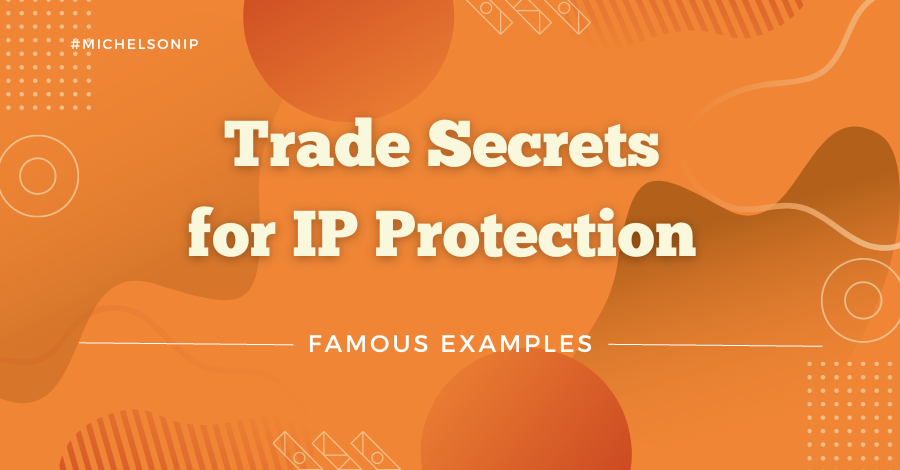Famous trade secrets are a hallmark of intellectual property law being put into practice. Think: Coca-Cola and WD-40. What do these well-known products have in common? They use trade secrets as a means of protecting their intellectual property. Coca-Cola protects its syrup formula, and WD-40 protects the formula used in its multi-use product. We’ll explore what a trade secret is and how they are used to protect IP.
Trade Secret Defined
What exactly is a trade secret? The United States Patent and Trademark Office (USPTO) defines it as follows:
- Is information that has either actual or potential independent economic value by virtue of not being generally known,
- has value to others who cannot legitimately obtain the information, and
- is subject to reasonable efforts to maintain its secrecy.
According to the USPTO, all three of these components are required to maintain trade secret protection. For example, if the CEO of Coca-Cola were to disclose the ingredients behind its syrup formula, the product would no longer be protected.
Interestingly enough, trade secret protection does not have a time limit for expiration like patents – as long as the information has not been publicly revealed, the protection continues indefinitely.
Using Trade Secrets to Protect IP: Coca-Cola
Coca-Cola is well known for the somewhat extreme measures it takes to ensure its formula remains secret. It houses the information in a high security vault in Atlanta, Georgia. In addition, only two employees of the company know the formula at the same time. These employees don’t ever travel together, and their identities are not publicly disclosed.
This is a rather extreme example of protective measures, as the Coca-Cola formula is a commercially valuable piece of information. While it is important to take precautions, there are some other equally efficient, yet more cost-effective ways to obtain trade secret protection:
- Ensure all confidential information is indicated as such – this can be as simple as stamping documents “confidential.”
- Utilize locking cabinets or desks to ensure access to confidential documents is limited.
- Confidentiality agreements and non-disclosure agreements should be utilized for employees, contractors, vendors, or anyone who comes into contact with the trade secret information.
- Limit exposure to confidential information for those who “need to know.” Not everyone needs to know confidential information in order to perform their job duties.
Patent or Trade Secret: WD-40
On their website, the WD-40 Company states they never even filed for a patent, and that “only a single person knows every exact ingredient that goes into the famous formula.” Why would a company opt for trade secret protection versus patent protection?
Filing for a patent takes quite a bit of work, as well as financial resources. In addition, there is a time limit for patent protection, usually around 20 years. Also, a patent requires the inventor to disclose a great deal of information about the product or invention.
However, a patent provides greater protection for an inventor. The holder of a patent has a monopoly on the rights to the invention or product, even if a competitor “reverse engineers” a process and discovers its intricacies.
In contrast, a trade secret does not entail any costs or even paperwork. As discussed earlier, to be considered a trade secret, the information and product must have economic value, including value to others who cannot obtain the information, and the owner must take significant steps to protect the information and keep it secret.
The fact that a trade secret’s protection is potentially indefinite is also a big plus over a patent. However, a cause of action for a trade secret violation can only be initiated for an unlawful breach, such as if someone stole documents in order to obtain the secret information. If a party somehow reverse engineers a product and discovers the secret, there is no infringement. The other party could even file a patent on their product, which is a significant risk to the first company. Options must be examined on a case-by-case basis to determine which course of action will best suit a particular business.
A company like WD-40 likely weighed these options, and found that it was a better business to utilize trade secret protection versus obtaining a patent. As such, they take many steps to protect the information. It seems to work for them, as the formula for WD-40 has remained a secret for 60 years and is still protected.
Artificial Intelligence and Trade Secrets
Artificial intelligence (AI) is a hot topic these days. One may think AI, particularly algorithms, is generally protected by patents, but because of a 2014 U.S. Supreme Court case, this is not always feasible. In Alice Corp. v. CLS Bank International, 134 S.Ct. 2347 (2014), the court developed an eligibility test, stating an algorithm is only patentable if it is an abstract idea that can be “converted into a method that is unique, novel, non-obvious, and useful. “
Because of this case, as well as the speed in which technology changes, protecting AI algorithms through trade secrets has proven to be a better solution. As the AI landscape continues to develop, more and more companies will protect their data and models through the use of trade secrets, as it is cost effective and efficient.
Further Reading
5 IP Legal Agreements You Should Know About + Templates
How to Protect Your Company’s IP – Employee Policies (Part 1)
_________
 The Michelson Institute for Intellectual Property, an initiative of the Michelson 20MM Foundation, provides access to empowering IP education for budding inventors and entrepreneurs. Michelson 20MM was founded thanks to the generous support of renowned spinal surgeon Dr. Gary K. Michelson and Alya Michelson. To learn more, visit 20mm.org.
The Michelson Institute for Intellectual Property, an initiative of the Michelson 20MM Foundation, provides access to empowering IP education for budding inventors and entrepreneurs. Michelson 20MM was founded thanks to the generous support of renowned spinal surgeon Dr. Gary K. Michelson and Alya Michelson. To learn more, visit 20mm.org.
